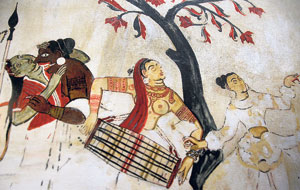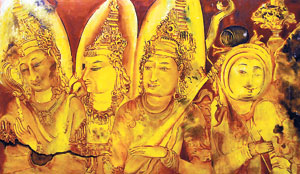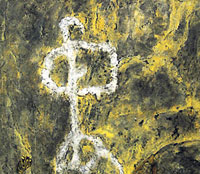Guttila panditha plays the veena to the royal audience in a contest with his pupil Musila while young dancers watch in fascination. The illustration that depicts this episode from the infamous jathaka tale of Guttila panditha who was a skilled musician serving King Brahmadatta of North India is taken from a 12th Century AC painting from Thivanka pilimage in Polonnaruwa - testimony to Sri Lanka’s rich painting tradition.
While the original paintings of historical value found in temples and caves are seldom noticed, the country’s veteran artists have done their part to save this rich heritage for future generations by making duplicates of the originals from time to time. The newly refurbished and redesigned Painting Gallery of the Colombo National Museum which will be opened to the public from July 21, comprises a large collection of such paintings, by these veteran painters, covering the pre-historic to the Kandy period.
 |
A painting from the Kandyan period and below (2nd): A pre-historic painting and (1st) From the Polonnaruwa period. |
 |
|
“These paintings copied by the artists by looking at the originals over the years are of immense value to the present generation in their study of paintings and arts as most of the originals no longer exist,” says the Education Promoting Officer, Colombo National Museum Sanjeewani Widyarathne. The museum is now open seven days a week except on public holidays from 9 a.m. to 6.30 p.m.
One of the most eye-catching collections in the gallery is the display of rare Veddah art copied from the original caves paintings from more than 30 sites all over the country such as Tantirimale, Andiyangala, and Dorawaka. The cave paintings, believed to have been the work of the Veddah community on walls and stones depict their hunting expeditions, their dances, lifestyle etc.
The oldest paintings in the collection are of course, the Sigiriya frescoes and the rock ceiling of the Naipena Guhava and these reproductions were done in 1896 and 1898 by D.A.L Perera who was the first draughtsman of the Archaeological Survey under the first Archaeological Commissioner H.C.P Bell.
Paintings from the Polonnaruwa period paintings reveal the influence of Indian tradition. Some of these depict Lord Buddha’s descent from heaven, the gods assembled on this occasion and the Guttila story. The artist D.J. Lokuge painted these from Maravidiya, Dimbulagala, Thivanka Pilimage and Polonnaruwa in 1931-1933 while the paintings of Hindagala and Galviharaya also belonging to this period were reproduced by draughtsman W. M. Fernando.
Bringing the Kandy period art to the forefront is the 18th Century AC painting of Buddha’s mara parajaya (The Defeat of the Mara demons) displayed at the gallery. This being a popular theme among Kandy period folk artists, the picture tells the story of how ferocious, multi-handed mara demons approach Lord Buddha with weapons while Buddha is seated under a Bo tree after attaining Buddha hood. Artist Stanley Abeysinghe has been instrumental in making a collection of gods from Pulligoda Galge in 1955 while D.A Amarasinghe, S.P. Charles and L.T.P. Manjusri made a Kandyan and low country collection of paintings from Degaldoruwa, Hanguranketha, Kelaniya and Kotte Raja Maha Viharaya.
The collection of Bali paintings bring out yet another popular aspect of local tradition and culture where bali ceremonies were part and parcel of folklore to dispel malefic effects from the lives of villagers. These bali figures were very popular in folk arts, sculpture and poetic literature. This 20th Century painting collection found in the museum is reproduced by J.E Sedaraman.
Of interest too is the collection of Pethikada paintings. Most are originals from temples in and around Kandy. Done on cloth, they belong to the 18th Century. Most of them are visual descriptions of Buddhist teachings, scenes depicting life and incidents of Lord Buddha’s enlightenment under the Bo tree, etc.
The most recent reproductions include paintings from Mulkirigala, Valalgoda and Lankathilaka done by M.M. Dayananda Peiris of the Colombo Museum. |




